Leadership, Management, and Operations: A Case Study of Ford Motors
VerifiedAdded on 2020/06/06
|12
|4005
|450
Report
AI Summary
This report provides an in-depth analysis of management and operations within Ford Motor Company. It begins with an introduction to Ford's operational strategies and the significance of effective management in the automotive industry. The report examines the various roles and responsibilities of managers and leaders, highlighting key differences and illustrating their functions through examples from Ford's organizational structure. It delves into the application of leadership theories, including situational, systems, and contingency approaches, and how these models are utilized to address challenges and achieve organizational objectives. Furthermore, the report explores operational management approaches, the impact of decision-making, and factors that influence operational processes. The report also discusses the implementation of the Six Sigma and DIMAC models within Ford, illustrating how these tools are used to improve efficiency, reduce costs, and enhance customer satisfaction. Overall, the report offers a comprehensive overview of how Ford Motors integrates leadership, management, and operational strategies to maintain its competitive edge and achieve its business goals.
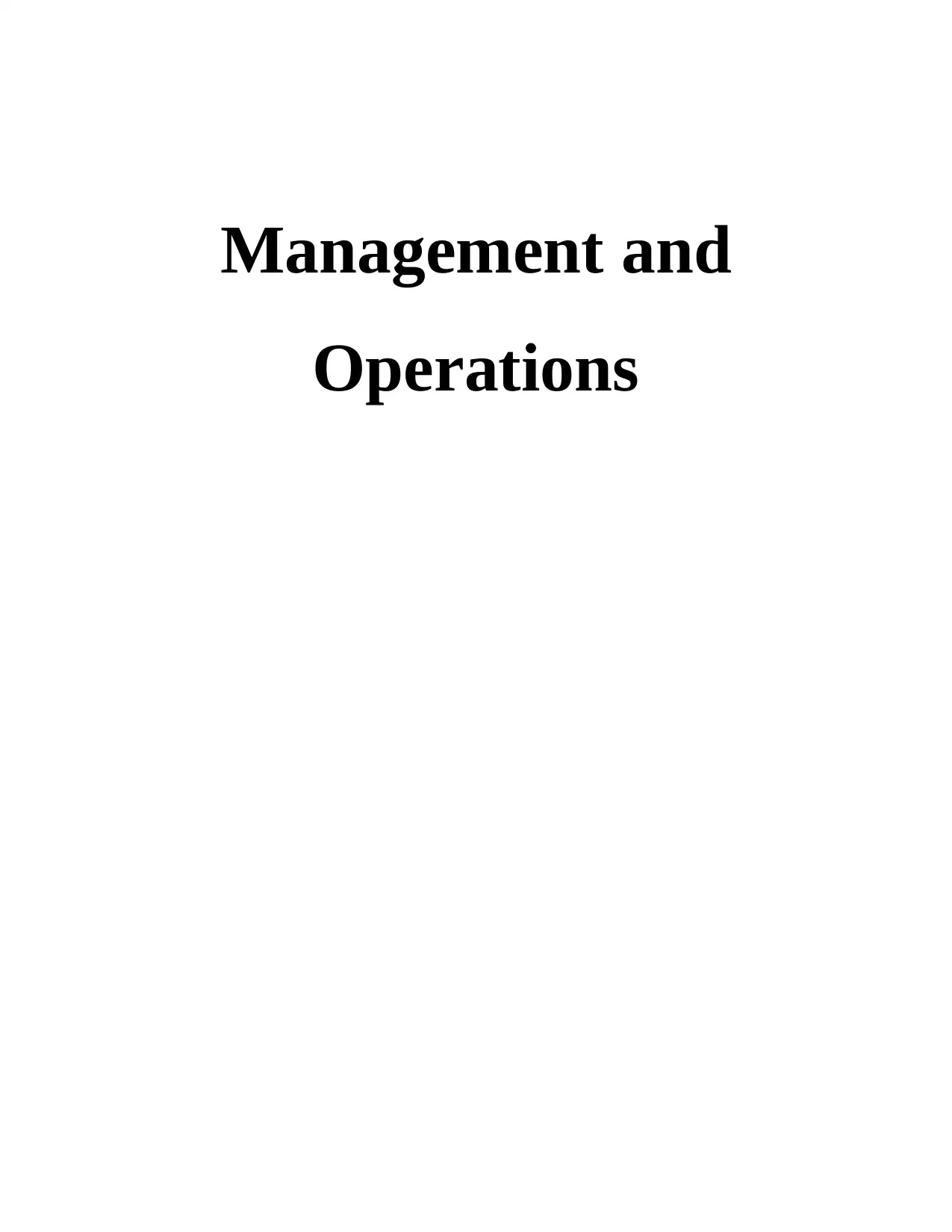
Management and
Operations
Operations
Paraphrase This Document
Need a fresh take? Get an instant paraphrase of this document with our AI Paraphraser

Table of Contents
INTRODUCTION...........................................................................................................................2
TASK 1............................................................................................................................................2
P1 Various roles and responsibilities of managers and leaders in Context of Ford....................2
TASK 2............................................................................................................................................4
P2 Application of roles and responsibilities of managers and leaders in situational context of
Ford.............................................................................................................................................4
P3 Apply different theories and models of approach, including situational leadership, systems
leadership and contingency. .......................................................................................................5
TASK 3............................................................................................................................................7
P4 Key approaches to operations management and the role that leaders and managers............7
P5 Value of management and operations in attaining organisation objectives...........................8
TASK 4............................................................................................................................................9
P6 Factors which impact upon operational management and decision-making by Leaders and
managers.....................................................................................................................................9
CONCLUSION..............................................................................................................................10
REFERENCES..............................................................................................................................11
1
INTRODUCTION...........................................................................................................................2
TASK 1............................................................................................................................................2
P1 Various roles and responsibilities of managers and leaders in Context of Ford....................2
TASK 2............................................................................................................................................4
P2 Application of roles and responsibilities of managers and leaders in situational context of
Ford.............................................................................................................................................4
P3 Apply different theories and models of approach, including situational leadership, systems
leadership and contingency. .......................................................................................................5
TASK 3............................................................................................................................................7
P4 Key approaches to operations management and the role that leaders and managers............7
P5 Value of management and operations in attaining organisation objectives...........................8
TASK 4............................................................................................................................................9
P6 Factors which impact upon operational management and decision-making by Leaders and
managers.....................................................................................................................................9
CONCLUSION..............................................................................................................................10
REFERENCES..............................................................................................................................11
1
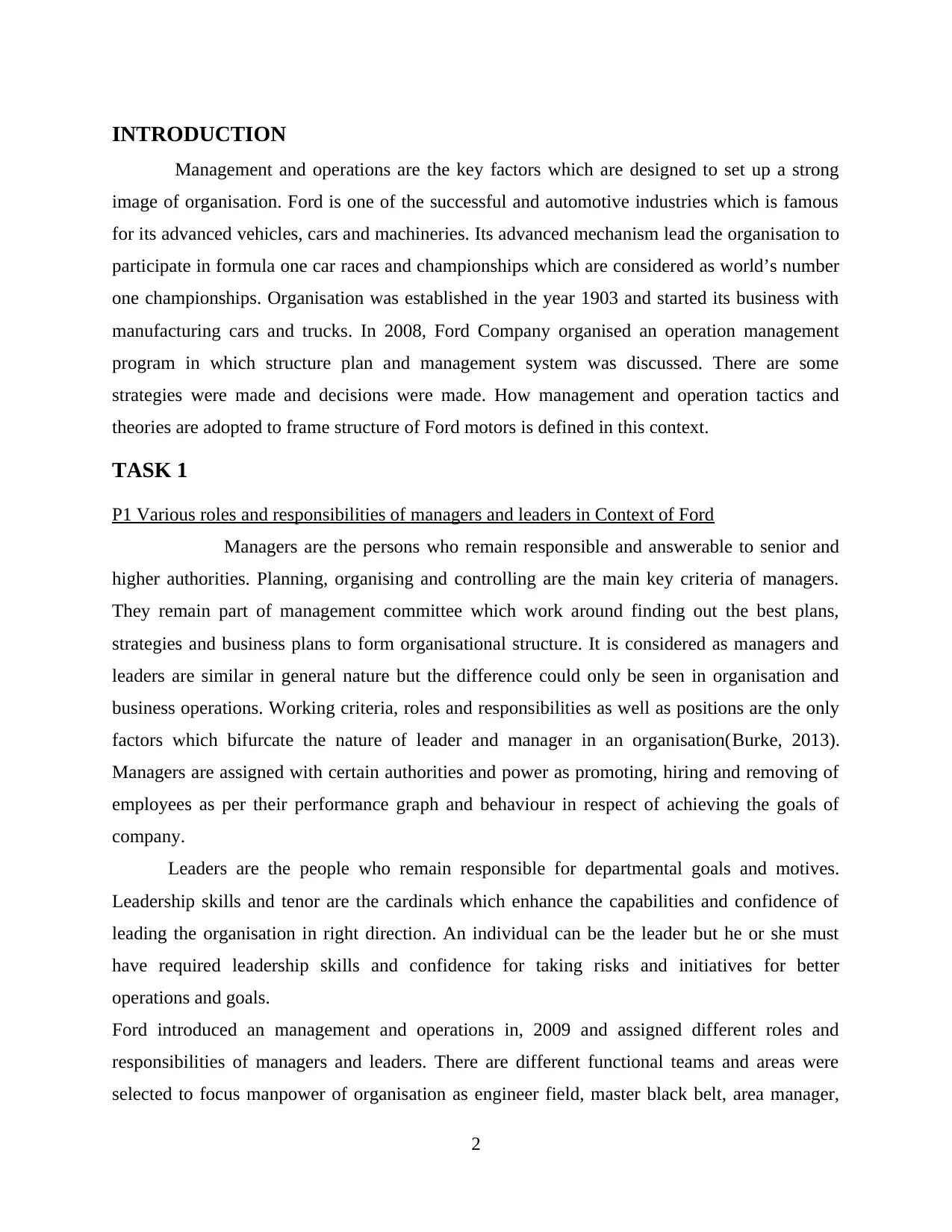
INTRODUCTION
Management and operations are the key factors which are designed to set up a strong
image of organisation. Ford is one of the successful and automotive industries which is famous
for its advanced vehicles, cars and machineries. Its advanced mechanism lead the organisation to
participate in formula one car races and championships which are considered as world’s number
one championships. Organisation was established in the year 1903 and started its business with
manufacturing cars and trucks. In 2008, Ford Company organised an operation management
program in which structure plan and management system was discussed. There are some
strategies were made and decisions were made. How management and operation tactics and
theories are adopted to frame structure of Ford motors is defined in this context.
TASK 1
P1 Various roles and responsibilities of managers and leaders in Context of Ford
Managers are the persons who remain responsible and answerable to senior and
higher authorities. Planning, organising and controlling are the main key criteria of managers.
They remain part of management committee which work around finding out the best plans,
strategies and business plans to form organisational structure. It is considered as managers and
leaders are similar in general nature but the difference could only be seen in organisation and
business operations. Working criteria, roles and responsibilities as well as positions are the only
factors which bifurcate the nature of leader and manager in an organisation(Burke, 2013).
Managers are assigned with certain authorities and power as promoting, hiring and removing of
employees as per their performance graph and behaviour in respect of achieving the goals of
company.
Leaders are the people who remain responsible for departmental goals and motives.
Leadership skills and tenor are the cardinals which enhance the capabilities and confidence of
leading the organisation in right direction. An individual can be the leader but he or she must
have required leadership skills and confidence for taking risks and initiatives for better
operations and goals.
Ford introduced an management and operations in, 2009 and assigned different roles and
responsibilities of managers and leaders. There are different functional teams and areas were
selected to focus manpower of organisation as engineer field, master black belt, area manager,
2
Management and operations are the key factors which are designed to set up a strong
image of organisation. Ford is one of the successful and automotive industries which is famous
for its advanced vehicles, cars and machineries. Its advanced mechanism lead the organisation to
participate in formula one car races and championships which are considered as world’s number
one championships. Organisation was established in the year 1903 and started its business with
manufacturing cars and trucks. In 2008, Ford Company organised an operation management
program in which structure plan and management system was discussed. There are some
strategies were made and decisions were made. How management and operation tactics and
theories are adopted to frame structure of Ford motors is defined in this context.
TASK 1
P1 Various roles and responsibilities of managers and leaders in Context of Ford
Managers are the persons who remain responsible and answerable to senior and
higher authorities. Planning, organising and controlling are the main key criteria of managers.
They remain part of management committee which work around finding out the best plans,
strategies and business plans to form organisational structure. It is considered as managers and
leaders are similar in general nature but the difference could only be seen in organisation and
business operations. Working criteria, roles and responsibilities as well as positions are the only
factors which bifurcate the nature of leader and manager in an organisation(Burke, 2013).
Managers are assigned with certain authorities and power as promoting, hiring and removing of
employees as per their performance graph and behaviour in respect of achieving the goals of
company.
Leaders are the people who remain responsible for departmental goals and motives.
Leadership skills and tenor are the cardinals which enhance the capabilities and confidence of
leading the organisation in right direction. An individual can be the leader but he or she must
have required leadership skills and confidence for taking risks and initiatives for better
operations and goals.
Ford introduced an management and operations in, 2009 and assigned different roles and
responsibilities of managers and leaders. There are different functional teams and areas were
selected to focus manpower of organisation as engineer field, master black belt, area manager,
2
⊘ This is a preview!⊘
Do you want full access?
Subscribe today to unlock all pages.

Trusted by 1+ million students worldwide
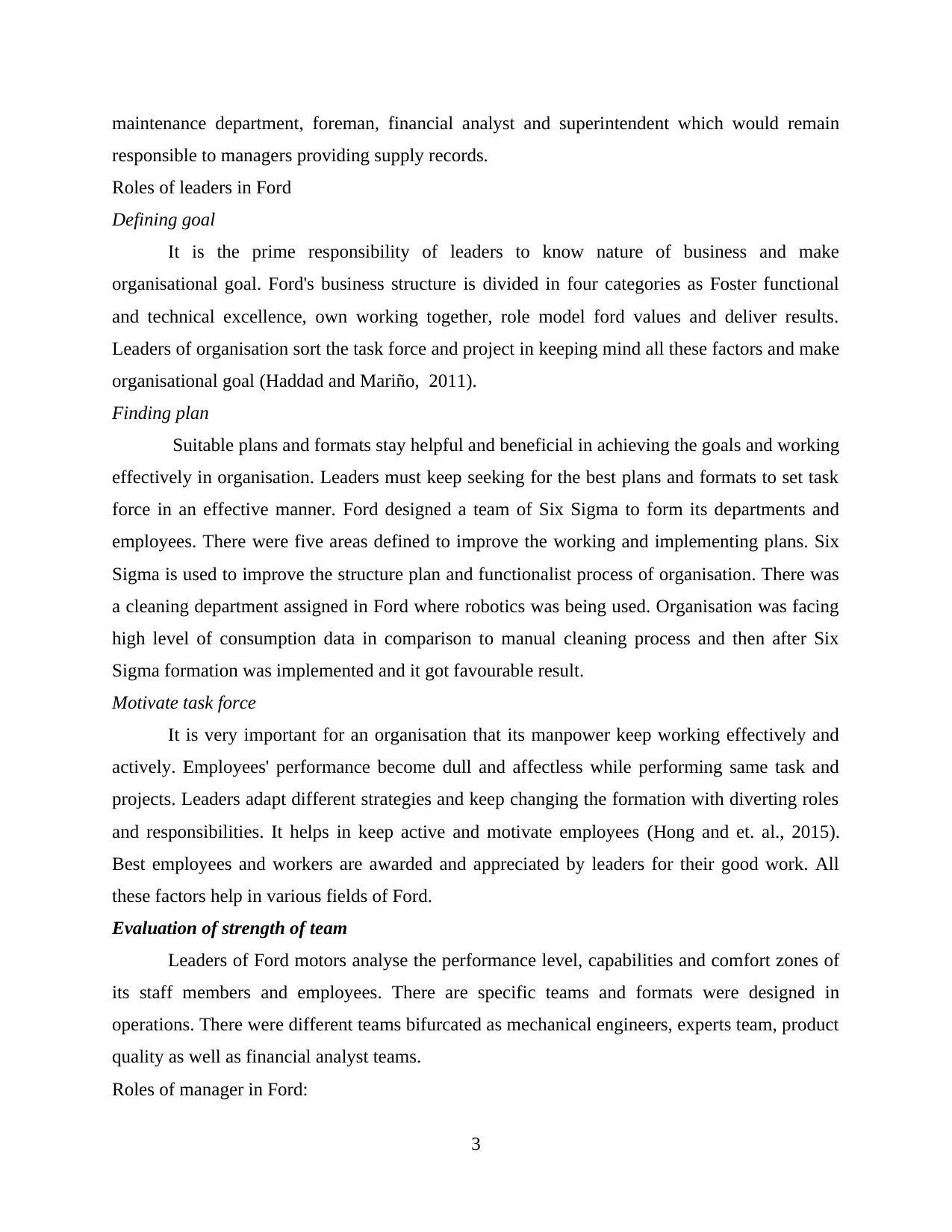
maintenance department, foreman, financial analyst and superintendent which would remain
responsible to managers providing supply records.
Roles of leaders in Ford
Defining goal
It is the prime responsibility of leaders to know nature of business and make
organisational goal. Ford's business structure is divided in four categories as Foster functional
and technical excellence, own working together, role model ford values and deliver results.
Leaders of organisation sort the task force and project in keeping mind all these factors and make
organisational goal (Haddad and Mariño, 2011).
Finding plan
Suitable plans and formats stay helpful and beneficial in achieving the goals and working
effectively in organisation. Leaders must keep seeking for the best plans and formats to set task
force in an effective manner. Ford designed a team of Six Sigma to form its departments and
employees. There were five areas defined to improve the working and implementing plans. Six
Sigma is used to improve the structure plan and functionalist process of organisation. There was
a cleaning department assigned in Ford where robotics was being used. Organisation was facing
high level of consumption data in comparison to manual cleaning process and then after Six
Sigma formation was implemented and it got favourable result.
Motivate task force
It is very important for an organisation that its manpower keep working effectively and
actively. Employees' performance become dull and affectless while performing same task and
projects. Leaders adapt different strategies and keep changing the formation with diverting roles
and responsibilities. It helps in keep active and motivate employees (Hong and et. al., 2015).
Best employees and workers are awarded and appreciated by leaders for their good work. All
these factors help in various fields of Ford.
Evaluation of strength of team
Leaders of Ford motors analyse the performance level, capabilities and comfort zones of
its staff members and employees. There are specific teams and formats were designed in
operations. There were different teams bifurcated as mechanical engineers, experts team, product
quality as well as financial analyst teams.
Roles of manager in Ford:
3
responsible to managers providing supply records.
Roles of leaders in Ford
Defining goal
It is the prime responsibility of leaders to know nature of business and make
organisational goal. Ford's business structure is divided in four categories as Foster functional
and technical excellence, own working together, role model ford values and deliver results.
Leaders of organisation sort the task force and project in keeping mind all these factors and make
organisational goal (Haddad and Mariño, 2011).
Finding plan
Suitable plans and formats stay helpful and beneficial in achieving the goals and working
effectively in organisation. Leaders must keep seeking for the best plans and formats to set task
force in an effective manner. Ford designed a team of Six Sigma to form its departments and
employees. There were five areas defined to improve the working and implementing plans. Six
Sigma is used to improve the structure plan and functionalist process of organisation. There was
a cleaning department assigned in Ford where robotics was being used. Organisation was facing
high level of consumption data in comparison to manual cleaning process and then after Six
Sigma formation was implemented and it got favourable result.
Motivate task force
It is very important for an organisation that its manpower keep working effectively and
actively. Employees' performance become dull and affectless while performing same task and
projects. Leaders adapt different strategies and keep changing the formation with diverting roles
and responsibilities. It helps in keep active and motivate employees (Hong and et. al., 2015).
Best employees and workers are awarded and appreciated by leaders for their good work. All
these factors help in various fields of Ford.
Evaluation of strength of team
Leaders of Ford motors analyse the performance level, capabilities and comfort zones of
its staff members and employees. There are specific teams and formats were designed in
operations. There were different teams bifurcated as mechanical engineers, experts team, product
quality as well as financial analyst teams.
Roles of manager in Ford:
3
Paraphrase This Document
Need a fresh take? Get an instant paraphrase of this document with our AI Paraphraser
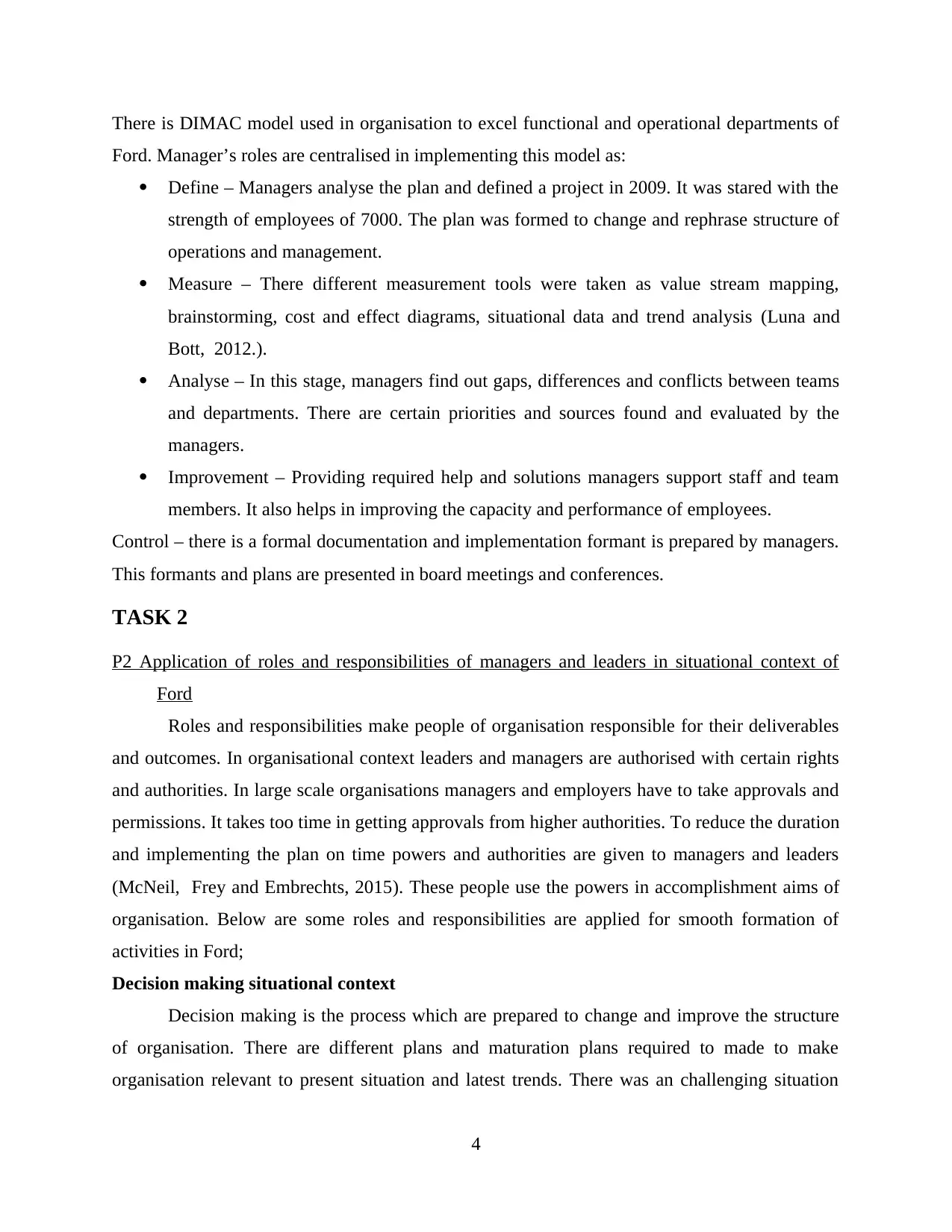
There is DIMAC model used in organisation to excel functional and operational departments of
Ford. Manager’s roles are centralised in implementing this model as:
Define – Managers analyse the plan and defined a project in 2009. It was stared with the
strength of employees of 7000. The plan was formed to change and rephrase structure of
operations and management.
Measure – There different measurement tools were taken as value stream mapping,
brainstorming, cost and effect diagrams, situational data and trend analysis (Luna and
Bott, 2012.).
Analyse – In this stage, managers find out gaps, differences and conflicts between teams
and departments. There are certain priorities and sources found and evaluated by the
managers.
Improvement – Providing required help and solutions managers support staff and team
members. It also helps in improving the capacity and performance of employees.
Control – there is a formal documentation and implementation formant is prepared by managers.
This formants and plans are presented in board meetings and conferences.
TASK 2
P2 Application of roles and responsibilities of managers and leaders in situational context of
Ford
Roles and responsibilities make people of organisation responsible for their deliverables
and outcomes. In organisational context leaders and managers are authorised with certain rights
and authorities. In large scale organisations managers and employers have to take approvals and
permissions. It takes too time in getting approvals from higher authorities. To reduce the duration
and implementing the plan on time powers and authorities are given to managers and leaders
(McNeil, Frey and Embrechts, 2015). These people use the powers in accomplishment aims of
organisation. Below are some roles and responsibilities are applied for smooth formation of
activities in Ford;
Decision making situational context
Decision making is the process which are prepared to change and improve the structure
of organisation. There are different plans and maturation plans required to made to make
organisation relevant to present situation and latest trends. There was an challenging situation
4
Ford. Manager’s roles are centralised in implementing this model as:
Define – Managers analyse the plan and defined a project in 2009. It was stared with the
strength of employees of 7000. The plan was formed to change and rephrase structure of
operations and management.
Measure – There different measurement tools were taken as value stream mapping,
brainstorming, cost and effect diagrams, situational data and trend analysis (Luna and
Bott, 2012.).
Analyse – In this stage, managers find out gaps, differences and conflicts between teams
and departments. There are certain priorities and sources found and evaluated by the
managers.
Improvement – Providing required help and solutions managers support staff and team
members. It also helps in improving the capacity and performance of employees.
Control – there is a formal documentation and implementation formant is prepared by managers.
This formants and plans are presented in board meetings and conferences.
TASK 2
P2 Application of roles and responsibilities of managers and leaders in situational context of
Ford
Roles and responsibilities make people of organisation responsible for their deliverables
and outcomes. In organisational context leaders and managers are authorised with certain rights
and authorities. In large scale organisations managers and employers have to take approvals and
permissions. It takes too time in getting approvals from higher authorities. To reduce the duration
and implementing the plan on time powers and authorities are given to managers and leaders
(McNeil, Frey and Embrechts, 2015). These people use the powers in accomplishment aims of
organisation. Below are some roles and responsibilities are applied for smooth formation of
activities in Ford;
Decision making situational context
Decision making is the process which are prepared to change and improve the structure
of organisation. There are different plans and maturation plans required to made to make
organisation relevant to present situation and latest trends. There was an challenging situation
4
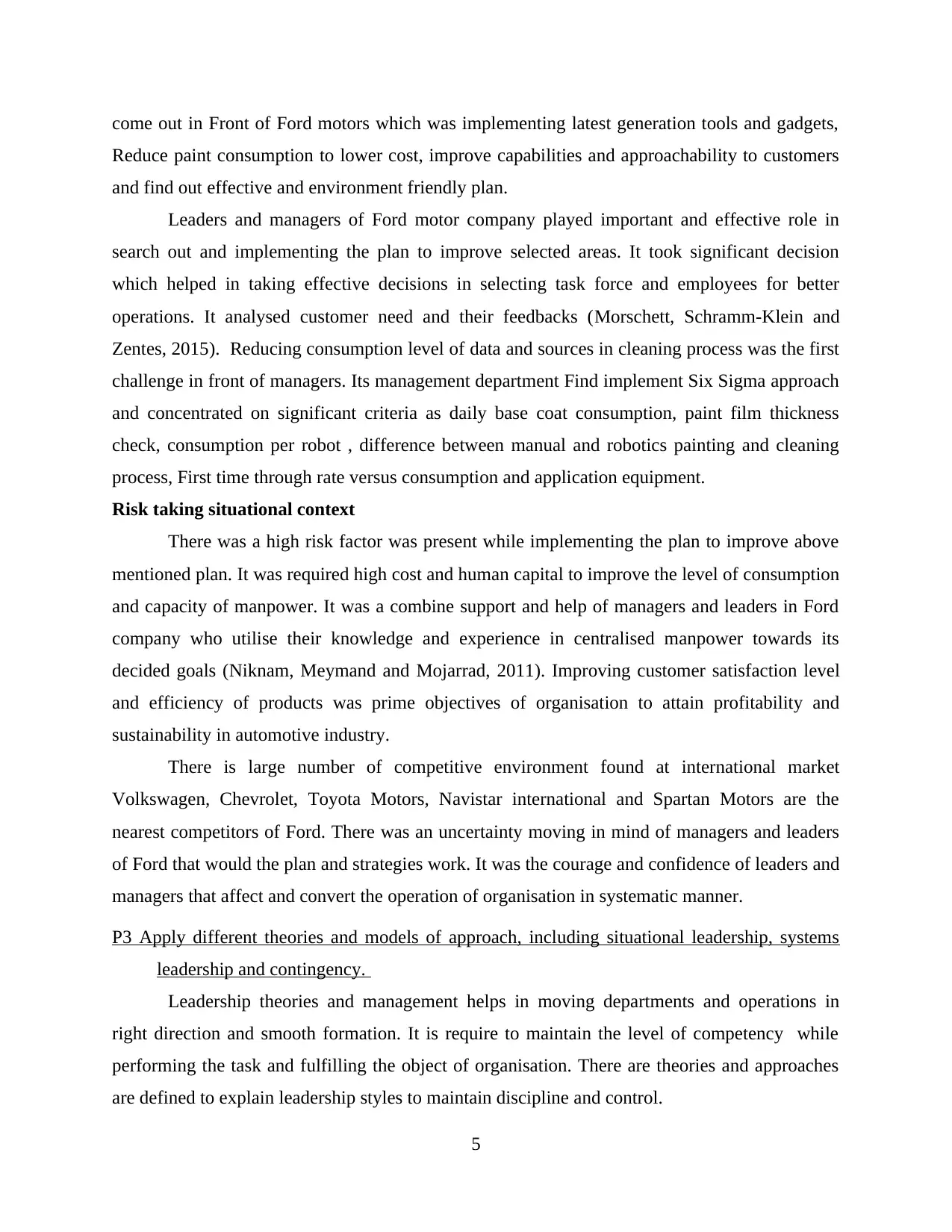
come out in Front of Ford motors which was implementing latest generation tools and gadgets,
Reduce paint consumption to lower cost, improve capabilities and approachability to customers
and find out effective and environment friendly plan.
Leaders and managers of Ford motor company played important and effective role in
search out and implementing the plan to improve selected areas. It took significant decision
which helped in taking effective decisions in selecting task force and employees for better
operations. It analysed customer need and their feedbacks (Morschett, Schramm-Klein and
Zentes, 2015). Reducing consumption level of data and sources in cleaning process was the first
challenge in front of managers. Its management department Find implement Six Sigma approach
and concentrated on significant criteria as daily base coat consumption, paint film thickness
check, consumption per robot , difference between manual and robotics painting and cleaning
process, First time through rate versus consumption and application equipment.
Risk taking situational context
There was a high risk factor was present while implementing the plan to improve above
mentioned plan. It was required high cost and human capital to improve the level of consumption
and capacity of manpower. It was a combine support and help of managers and leaders in Ford
company who utilise their knowledge and experience in centralised manpower towards its
decided goals (Niknam, Meymand and Mojarrad, 2011). Improving customer satisfaction level
and efficiency of products was prime objectives of organisation to attain profitability and
sustainability in automotive industry.
There is large number of competitive environment found at international market
Volkswagen, Chevrolet, Toyota Motors, Navistar international and Spartan Motors are the
nearest competitors of Ford. There was an uncertainty moving in mind of managers and leaders
of Ford that would the plan and strategies work. It was the courage and confidence of leaders and
managers that affect and convert the operation of organisation in systematic manner.
P3 Apply different theories and models of approach, including situational leadership, systems
leadership and contingency.
Leadership theories and management helps in moving departments and operations in
right direction and smooth formation. It is require to maintain the level of competency while
performing the task and fulfilling the object of organisation. There are theories and approaches
are defined to explain leadership styles to maintain discipline and control.
5
Reduce paint consumption to lower cost, improve capabilities and approachability to customers
and find out effective and environment friendly plan.
Leaders and managers of Ford motor company played important and effective role in
search out and implementing the plan to improve selected areas. It took significant decision
which helped in taking effective decisions in selecting task force and employees for better
operations. It analysed customer need and their feedbacks (Morschett, Schramm-Klein and
Zentes, 2015). Reducing consumption level of data and sources in cleaning process was the first
challenge in front of managers. Its management department Find implement Six Sigma approach
and concentrated on significant criteria as daily base coat consumption, paint film thickness
check, consumption per robot , difference between manual and robotics painting and cleaning
process, First time through rate versus consumption and application equipment.
Risk taking situational context
There was a high risk factor was present while implementing the plan to improve above
mentioned plan. It was required high cost and human capital to improve the level of consumption
and capacity of manpower. It was a combine support and help of managers and leaders in Ford
company who utilise their knowledge and experience in centralised manpower towards its
decided goals (Niknam, Meymand and Mojarrad, 2011). Improving customer satisfaction level
and efficiency of products was prime objectives of organisation to attain profitability and
sustainability in automotive industry.
There is large number of competitive environment found at international market
Volkswagen, Chevrolet, Toyota Motors, Navistar international and Spartan Motors are the
nearest competitors of Ford. There was an uncertainty moving in mind of managers and leaders
of Ford that would the plan and strategies work. It was the courage and confidence of leaders and
managers that affect and convert the operation of organisation in systematic manner.
P3 Apply different theories and models of approach, including situational leadership, systems
leadership and contingency.
Leadership theories and management helps in moving departments and operations in
right direction and smooth formation. It is require to maintain the level of competency while
performing the task and fulfilling the object of organisation. There are theories and approaches
are defined to explain leadership styles to maintain discipline and control.
5
⊘ This is a preview!⊘
Do you want full access?
Subscribe today to unlock all pages.

Trusted by 1+ million students worldwide
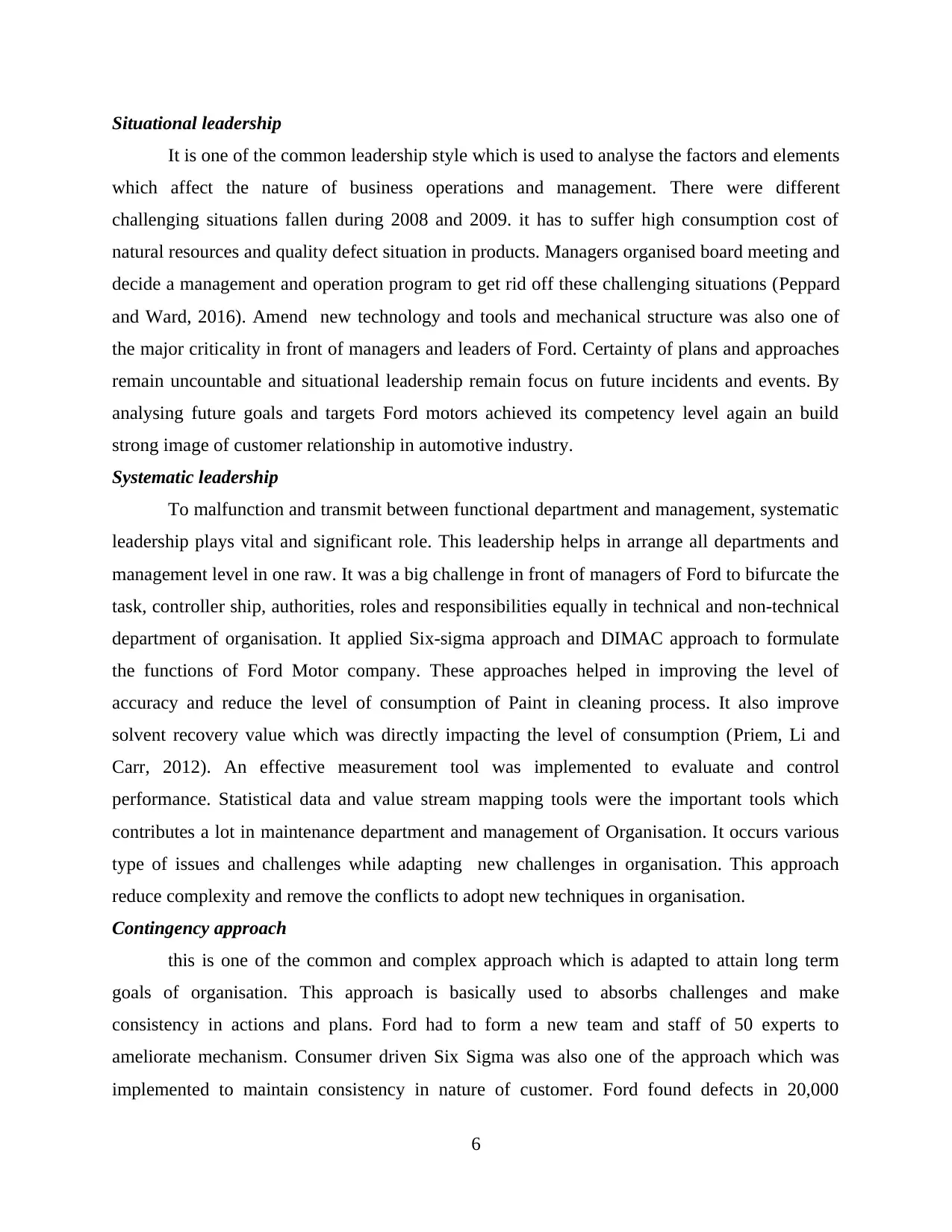
Situational leadership
It is one of the common leadership style which is used to analyse the factors and elements
which affect the nature of business operations and management. There were different
challenging situations fallen during 2008 and 2009. it has to suffer high consumption cost of
natural resources and quality defect situation in products. Managers organised board meeting and
decide a management and operation program to get rid off these challenging situations (Peppard
and Ward, 2016). Amend new technology and tools and mechanical structure was also one of
the major criticality in front of managers and leaders of Ford. Certainty of plans and approaches
remain uncountable and situational leadership remain focus on future incidents and events. By
analysing future goals and targets Ford motors achieved its competency level again an build
strong image of customer relationship in automotive industry.
Systematic leadership
To malfunction and transmit between functional department and management, systematic
leadership plays vital and significant role. This leadership helps in arrange all departments and
management level in one raw. It was a big challenge in front of managers of Ford to bifurcate the
task, controller ship, authorities, roles and responsibilities equally in technical and non-technical
department of organisation. It applied Six-sigma approach and DIMAC approach to formulate
the functions of Ford Motor company. These approaches helped in improving the level of
accuracy and reduce the level of consumption of Paint in cleaning process. It also improve
solvent recovery value which was directly impacting the level of consumption (Priem, Li and
Carr, 2012). An effective measurement tool was implemented to evaluate and control
performance. Statistical data and value stream mapping tools were the important tools which
contributes a lot in maintenance department and management of Organisation. It occurs various
type of issues and challenges while adapting new challenges in organisation. This approach
reduce complexity and remove the conflicts to adopt new techniques in organisation.
Contingency approach
this is one of the common and complex approach which is adapted to attain long term
goals of organisation. This approach is basically used to absorbs challenges and make
consistency in actions and plans. Ford had to form a new team and staff of 50 experts to
ameliorate mechanism. Consumer driven Six Sigma was also one of the approach which was
implemented to maintain consistency in nature of customer. Ford found defects in 20,000
6
It is one of the common leadership style which is used to analyse the factors and elements
which affect the nature of business operations and management. There were different
challenging situations fallen during 2008 and 2009. it has to suffer high consumption cost of
natural resources and quality defect situation in products. Managers organised board meeting and
decide a management and operation program to get rid off these challenging situations (Peppard
and Ward, 2016). Amend new technology and tools and mechanical structure was also one of
the major criticality in front of managers and leaders of Ford. Certainty of plans and approaches
remain uncountable and situational leadership remain focus on future incidents and events. By
analysing future goals and targets Ford motors achieved its competency level again an build
strong image of customer relationship in automotive industry.
Systematic leadership
To malfunction and transmit between functional department and management, systematic
leadership plays vital and significant role. This leadership helps in arrange all departments and
management level in one raw. It was a big challenge in front of managers of Ford to bifurcate the
task, controller ship, authorities, roles and responsibilities equally in technical and non-technical
department of organisation. It applied Six-sigma approach and DIMAC approach to formulate
the functions of Ford Motor company. These approaches helped in improving the level of
accuracy and reduce the level of consumption of Paint in cleaning process. It also improve
solvent recovery value which was directly impacting the level of consumption (Priem, Li and
Carr, 2012). An effective measurement tool was implemented to evaluate and control
performance. Statistical data and value stream mapping tools were the important tools which
contributes a lot in maintenance department and management of Organisation. It occurs various
type of issues and challenges while adapting new challenges in organisation. This approach
reduce complexity and remove the conflicts to adopt new techniques in organisation.
Contingency approach
this is one of the common and complex approach which is adapted to attain long term
goals of organisation. This approach is basically used to absorbs challenges and make
consistency in actions and plans. Ford had to form a new team and staff of 50 experts to
ameliorate mechanism. Consumer driven Six Sigma was also one of the approach which was
implemented to maintain consistency in nature of customer. Ford found defects in 20,000
6
Paraphrase This Document
Need a fresh take? Get an instant paraphrase of this document with our AI Paraphraser
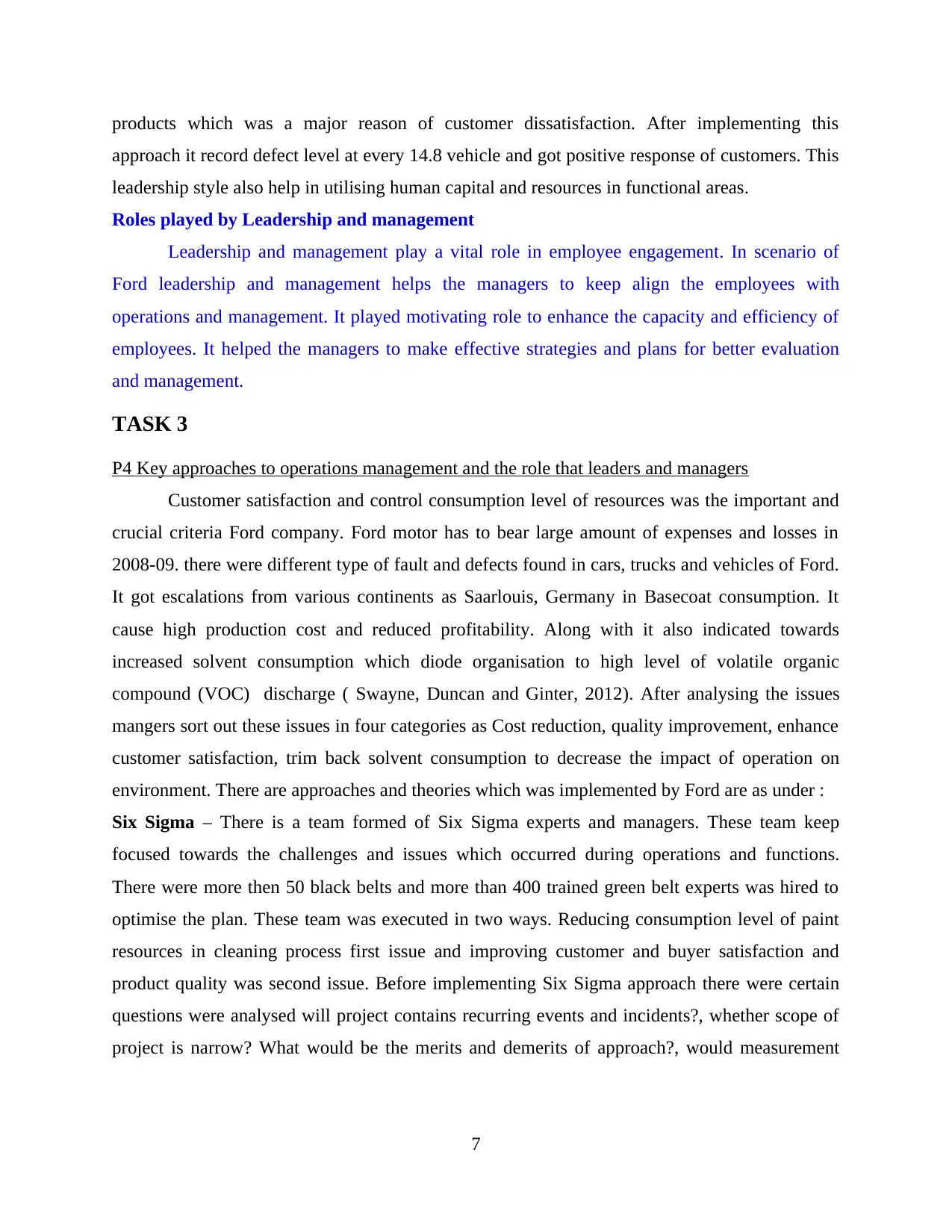
products which was a major reason of customer dissatisfaction. After implementing this
approach it record defect level at every 14.8 vehicle and got positive response of customers. This
leadership style also help in utilising human capital and resources in functional areas.
Roles played by Leadership and management
Leadership and management play a vital role in employee engagement. In scenario of
Ford leadership and management helps the managers to keep align the employees with
operations and management. It played motivating role to enhance the capacity and efficiency of
employees. It helped the managers to make effective strategies and plans for better evaluation
and management.
TASK 3
P4 Key approaches to operations management and the role that leaders and managers
Customer satisfaction and control consumption level of resources was the important and
crucial criteria Ford company. Ford motor has to bear large amount of expenses and losses in
2008-09. there were different type of fault and defects found in cars, trucks and vehicles of Ford.
It got escalations from various continents as Saarlouis, Germany in Basecoat consumption. It
cause high production cost and reduced profitability. Along with it also indicated towards
increased solvent consumption which diode organisation to high level of volatile organic
compound (VOC) discharge ( Swayne, Duncan and Ginter, 2012). After analysing the issues
mangers sort out these issues in four categories as Cost reduction, quality improvement, enhance
customer satisfaction, trim back solvent consumption to decrease the impact of operation on
environment. There are approaches and theories which was implemented by Ford are as under :
Six Sigma – There is a team formed of Six Sigma experts and managers. These team keep
focused towards the challenges and issues which occurred during operations and functions.
There were more then 50 black belts and more than 400 trained green belt experts was hired to
optimise the plan. These team was executed in two ways. Reducing consumption level of paint
resources in cleaning process first issue and improving customer and buyer satisfaction and
product quality was second issue. Before implementing Six Sigma approach there were certain
questions were analysed will project contains recurring events and incidents?, whether scope of
project is narrow? What would be the merits and demerits of approach?, would measurement
7
approach it record defect level at every 14.8 vehicle and got positive response of customers. This
leadership style also help in utilising human capital and resources in functional areas.
Roles played by Leadership and management
Leadership and management play a vital role in employee engagement. In scenario of
Ford leadership and management helps the managers to keep align the employees with
operations and management. It played motivating role to enhance the capacity and efficiency of
employees. It helped the managers to make effective strategies and plans for better evaluation
and management.
TASK 3
P4 Key approaches to operations management and the role that leaders and managers
Customer satisfaction and control consumption level of resources was the important and
crucial criteria Ford company. Ford motor has to bear large amount of expenses and losses in
2008-09. there were different type of fault and defects found in cars, trucks and vehicles of Ford.
It got escalations from various continents as Saarlouis, Germany in Basecoat consumption. It
cause high production cost and reduced profitability. Along with it also indicated towards
increased solvent consumption which diode organisation to high level of volatile organic
compound (VOC) discharge ( Swayne, Duncan and Ginter, 2012). After analysing the issues
mangers sort out these issues in four categories as Cost reduction, quality improvement, enhance
customer satisfaction, trim back solvent consumption to decrease the impact of operation on
environment. There are approaches and theories which was implemented by Ford are as under :
Six Sigma – There is a team formed of Six Sigma experts and managers. These team keep
focused towards the challenges and issues which occurred during operations and functions.
There were more then 50 black belts and more than 400 trained green belt experts was hired to
optimise the plan. These team was executed in two ways. Reducing consumption level of paint
resources in cleaning process first issue and improving customer and buyer satisfaction and
product quality was second issue. Before implementing Six Sigma approach there were certain
questions were analysed will project contains recurring events and incidents?, whether scope of
project is narrow? What would be the merits and demerits of approach?, would measurement
7
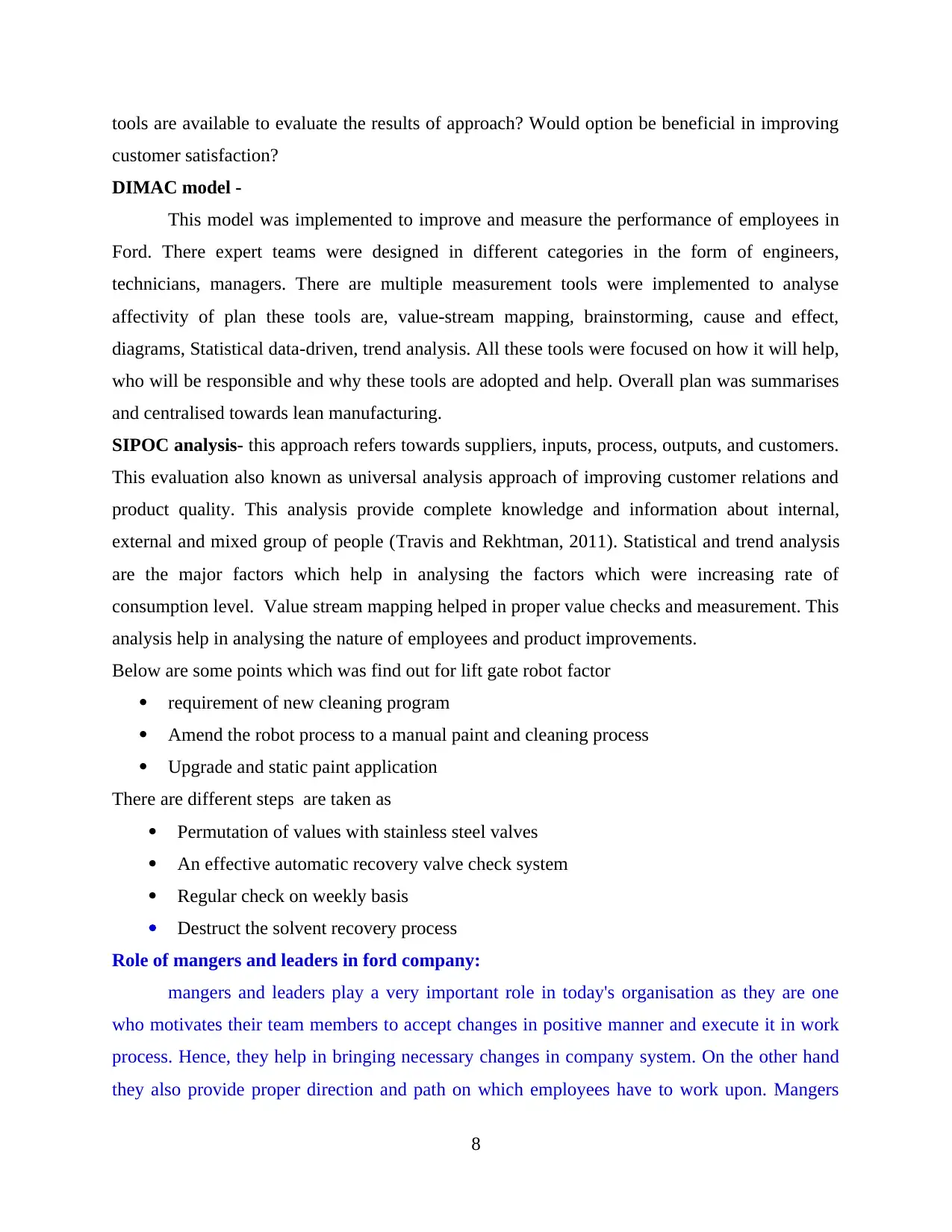
tools are available to evaluate the results of approach? Would option be beneficial in improving
customer satisfaction?
DIMAC model -
This model was implemented to improve and measure the performance of employees in
Ford. There expert teams were designed in different categories in the form of engineers,
technicians, managers. There are multiple measurement tools were implemented to analyse
affectivity of plan these tools are, value-stream mapping, brainstorming, cause and effect,
diagrams, Statistical data-driven, trend analysis. All these tools were focused on how it will help,
who will be responsible and why these tools are adopted and help. Overall plan was summarises
and centralised towards lean manufacturing.
SIPOC analysis- this approach refers towards suppliers, inputs, process, outputs, and customers.
This evaluation also known as universal analysis approach of improving customer relations and
product quality. This analysis provide complete knowledge and information about internal,
external and mixed group of people (Travis and Rekhtman, 2011). Statistical and trend analysis
are the major factors which help in analysing the factors which were increasing rate of
consumption level. Value stream mapping helped in proper value checks and measurement. This
analysis help in analysing the nature of employees and product improvements.
Below are some points which was find out for lift gate robot factor
requirement of new cleaning program
Amend the robot process to a manual paint and cleaning process
Upgrade and static paint application
There are different steps are taken as
Permutation of values with stainless steel valves
An effective automatic recovery valve check system
Regular check on weekly basis
Destruct the solvent recovery process
Role of mangers and leaders in ford company:
mangers and leaders play a very important role in today's organisation as they are one
who motivates their team members to accept changes in positive manner and execute it in work
process. Hence, they help in bringing necessary changes in company system. On the other hand
they also provide proper direction and path on which employees have to work upon. Mangers
8
customer satisfaction?
DIMAC model -
This model was implemented to improve and measure the performance of employees in
Ford. There expert teams were designed in different categories in the form of engineers,
technicians, managers. There are multiple measurement tools were implemented to analyse
affectivity of plan these tools are, value-stream mapping, brainstorming, cause and effect,
diagrams, Statistical data-driven, trend analysis. All these tools were focused on how it will help,
who will be responsible and why these tools are adopted and help. Overall plan was summarises
and centralised towards lean manufacturing.
SIPOC analysis- this approach refers towards suppliers, inputs, process, outputs, and customers.
This evaluation also known as universal analysis approach of improving customer relations and
product quality. This analysis provide complete knowledge and information about internal,
external and mixed group of people (Travis and Rekhtman, 2011). Statistical and trend analysis
are the major factors which help in analysing the factors which were increasing rate of
consumption level. Value stream mapping helped in proper value checks and measurement. This
analysis help in analysing the nature of employees and product improvements.
Below are some points which was find out for lift gate robot factor
requirement of new cleaning program
Amend the robot process to a manual paint and cleaning process
Upgrade and static paint application
There are different steps are taken as
Permutation of values with stainless steel valves
An effective automatic recovery valve check system
Regular check on weekly basis
Destruct the solvent recovery process
Role of mangers and leaders in ford company:
mangers and leaders play a very important role in today's organisation as they are one
who motivates their team members to accept changes in positive manner and execute it in work
process. Hence, they help in bringing necessary changes in company system. On the other hand
they also provide proper direction and path on which employees have to work upon. Mangers
8
⊘ This is a preview!⊘
Do you want full access?
Subscribe today to unlock all pages.

Trusted by 1+ million students worldwide
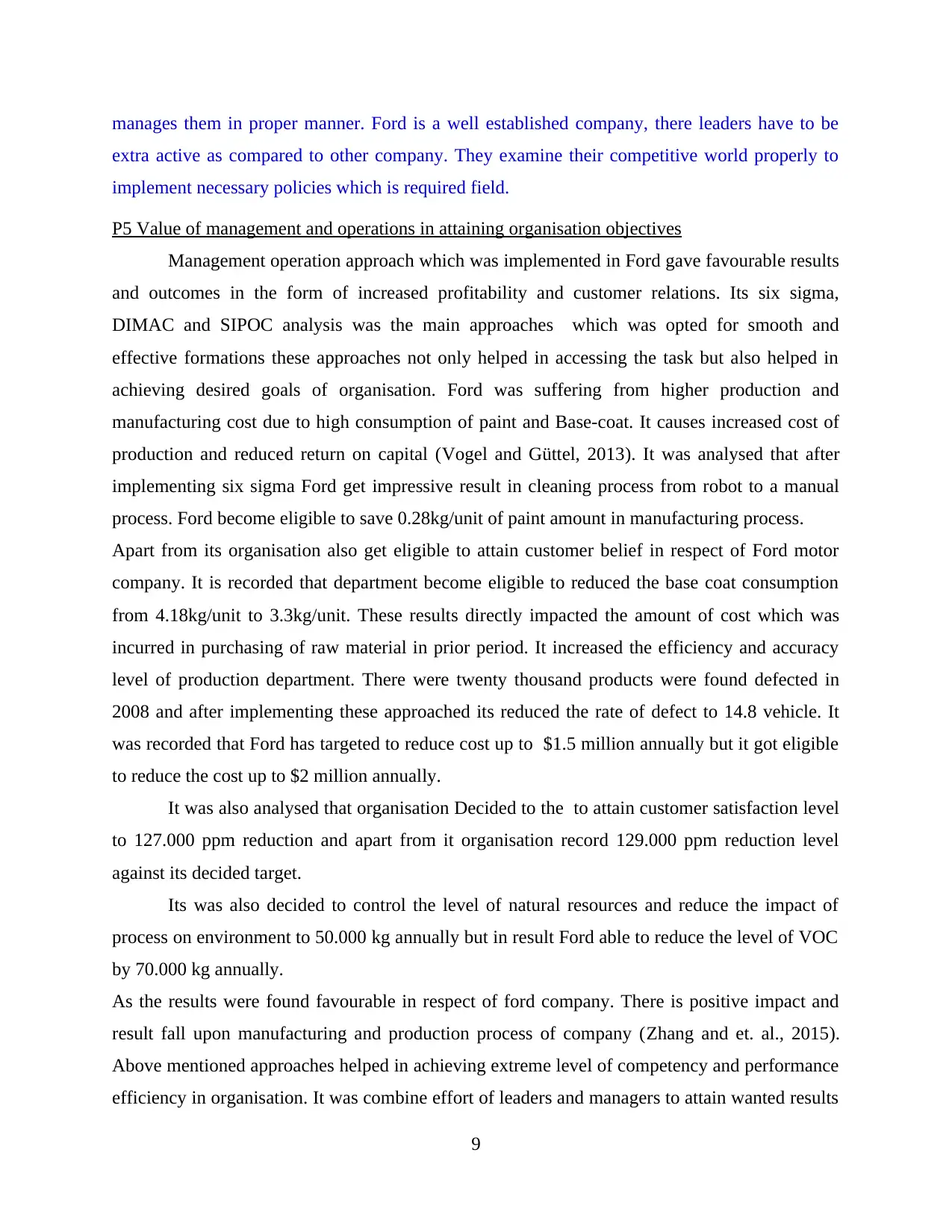
manages them in proper manner. Ford is a well established company, there leaders have to be
extra active as compared to other company. They examine their competitive world properly to
implement necessary policies which is required field.
P5 Value of management and operations in attaining organisation objectives
Management operation approach which was implemented in Ford gave favourable results
and outcomes in the form of increased profitability and customer relations. Its six sigma,
DIMAC and SIPOC analysis was the main approaches which was opted for smooth and
effective formations these approaches not only helped in accessing the task but also helped in
achieving desired goals of organisation. Ford was suffering from higher production and
manufacturing cost due to high consumption of paint and Base-coat. It causes increased cost of
production and reduced return on capital (Vogel and Güttel, 2013). It was analysed that after
implementing six sigma Ford get impressive result in cleaning process from robot to a manual
process. Ford become eligible to save 0.28kg/unit of paint amount in manufacturing process.
Apart from its organisation also get eligible to attain customer belief in respect of Ford motor
company. It is recorded that department become eligible to reduced the base coat consumption
from 4.18kg/unit to 3.3kg/unit. These results directly impacted the amount of cost which was
incurred in purchasing of raw material in prior period. It increased the efficiency and accuracy
level of production department. There were twenty thousand products were found defected in
2008 and after implementing these approached its reduced the rate of defect to 14.8 vehicle. It
was recorded that Ford has targeted to reduce cost up to $1.5 million annually but it got eligible
to reduce the cost up to $2 million annually.
It was also analysed that organisation Decided to the to attain customer satisfaction level
to 127.000 ppm reduction and apart from it organisation record 129.000 ppm reduction level
against its decided target.
Its was also decided to control the level of natural resources and reduce the impact of
process on environment to 50.000 kg annually but in result Ford able to reduce the level of VOC
by 70.000 kg annually.
As the results were found favourable in respect of ford company. There is positive impact and
result fall upon manufacturing and production process of company (Zhang and et. al., 2015).
Above mentioned approaches helped in achieving extreme level of competency and performance
efficiency in organisation. It was combine effort of leaders and managers to attain wanted results
9
extra active as compared to other company. They examine their competitive world properly to
implement necessary policies which is required field.
P5 Value of management and operations in attaining organisation objectives
Management operation approach which was implemented in Ford gave favourable results
and outcomes in the form of increased profitability and customer relations. Its six sigma,
DIMAC and SIPOC analysis was the main approaches which was opted for smooth and
effective formations these approaches not only helped in accessing the task but also helped in
achieving desired goals of organisation. Ford was suffering from higher production and
manufacturing cost due to high consumption of paint and Base-coat. It causes increased cost of
production and reduced return on capital (Vogel and Güttel, 2013). It was analysed that after
implementing six sigma Ford get impressive result in cleaning process from robot to a manual
process. Ford become eligible to save 0.28kg/unit of paint amount in manufacturing process.
Apart from its organisation also get eligible to attain customer belief in respect of Ford motor
company. It is recorded that department become eligible to reduced the base coat consumption
from 4.18kg/unit to 3.3kg/unit. These results directly impacted the amount of cost which was
incurred in purchasing of raw material in prior period. It increased the efficiency and accuracy
level of production department. There were twenty thousand products were found defected in
2008 and after implementing these approached its reduced the rate of defect to 14.8 vehicle. It
was recorded that Ford has targeted to reduce cost up to $1.5 million annually but it got eligible
to reduce the cost up to $2 million annually.
It was also analysed that organisation Decided to the to attain customer satisfaction level
to 127.000 ppm reduction and apart from it organisation record 129.000 ppm reduction level
against its decided target.
Its was also decided to control the level of natural resources and reduce the impact of
process on environment to 50.000 kg annually but in result Ford able to reduce the level of VOC
by 70.000 kg annually.
As the results were found favourable in respect of ford company. There is positive impact and
result fall upon manufacturing and production process of company (Zhang and et. al., 2015).
Above mentioned approaches helped in achieving extreme level of competency and performance
efficiency in organisation. It was combine effort of leaders and managers to attain wanted results
9
Paraphrase This Document
Need a fresh take? Get an instant paraphrase of this document with our AI Paraphraser
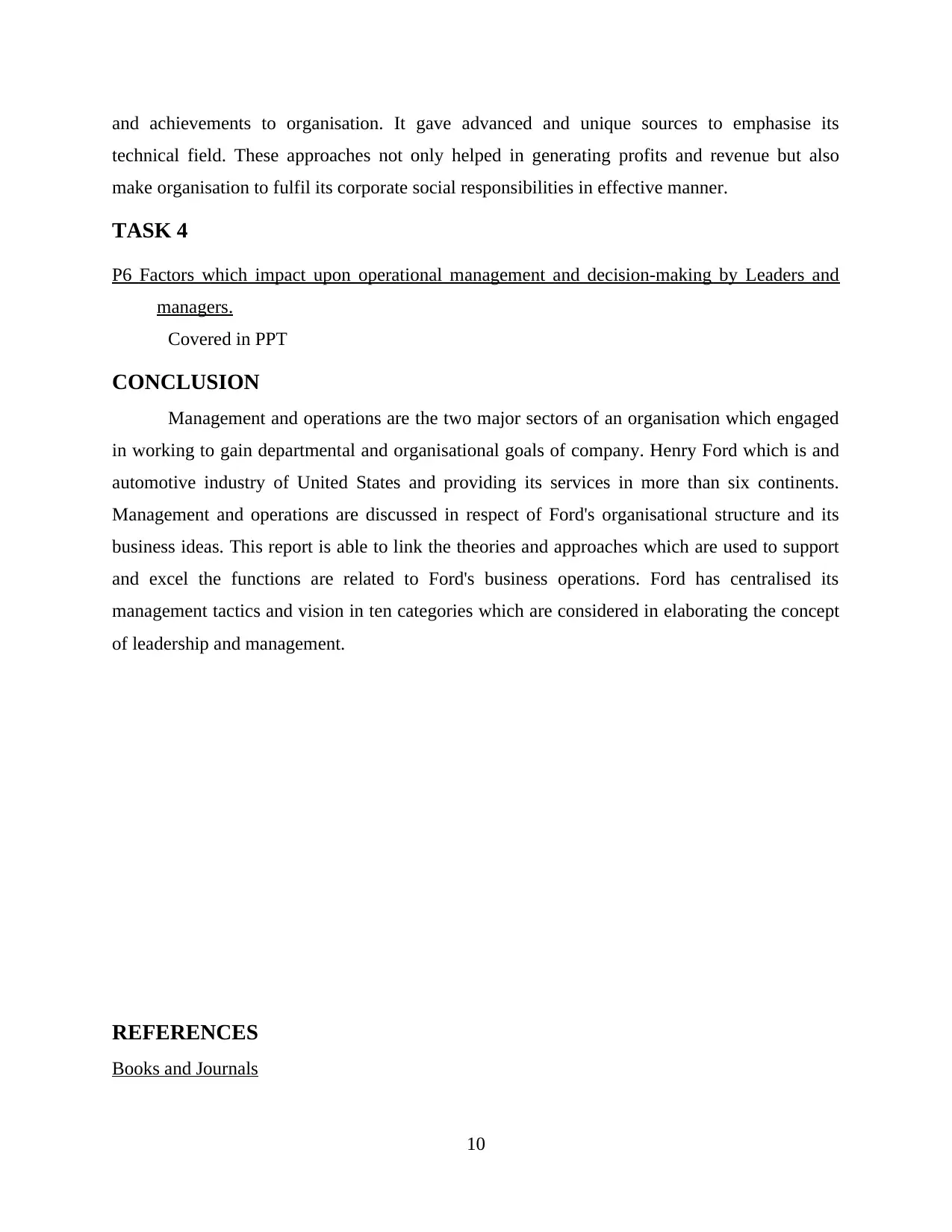
and achievements to organisation. It gave advanced and unique sources to emphasise its
technical field. These approaches not only helped in generating profits and revenue but also
make organisation to fulfil its corporate social responsibilities in effective manner.
TASK 4
P6 Factors which impact upon operational management and decision-making by Leaders and
managers.
Covered in PPT
CONCLUSION
Management and operations are the two major sectors of an organisation which engaged
in working to gain departmental and organisational goals of company. Henry Ford which is and
automotive industry of United States and providing its services in more than six continents.
Management and operations are discussed in respect of Ford's organisational structure and its
business ideas. This report is able to link the theories and approaches which are used to support
and excel the functions are related to Ford's business operations. Ford has centralised its
management tactics and vision in ten categories which are considered in elaborating the concept
of leadership and management.
REFERENCES
Books and Journals
10
technical field. These approaches not only helped in generating profits and revenue but also
make organisation to fulfil its corporate social responsibilities in effective manner.
TASK 4
P6 Factors which impact upon operational management and decision-making by Leaders and
managers.
Covered in PPT
CONCLUSION
Management and operations are the two major sectors of an organisation which engaged
in working to gain departmental and organisational goals of company. Henry Ford which is and
automotive industry of United States and providing its services in more than six continents.
Management and operations are discussed in respect of Ford's organisational structure and its
business ideas. This report is able to link the theories and approaches which are used to support
and excel the functions are related to Ford's business operations. Ford has centralised its
management tactics and vision in ten categories which are considered in elaborating the concept
of leadership and management.
REFERENCES
Books and Journals
10
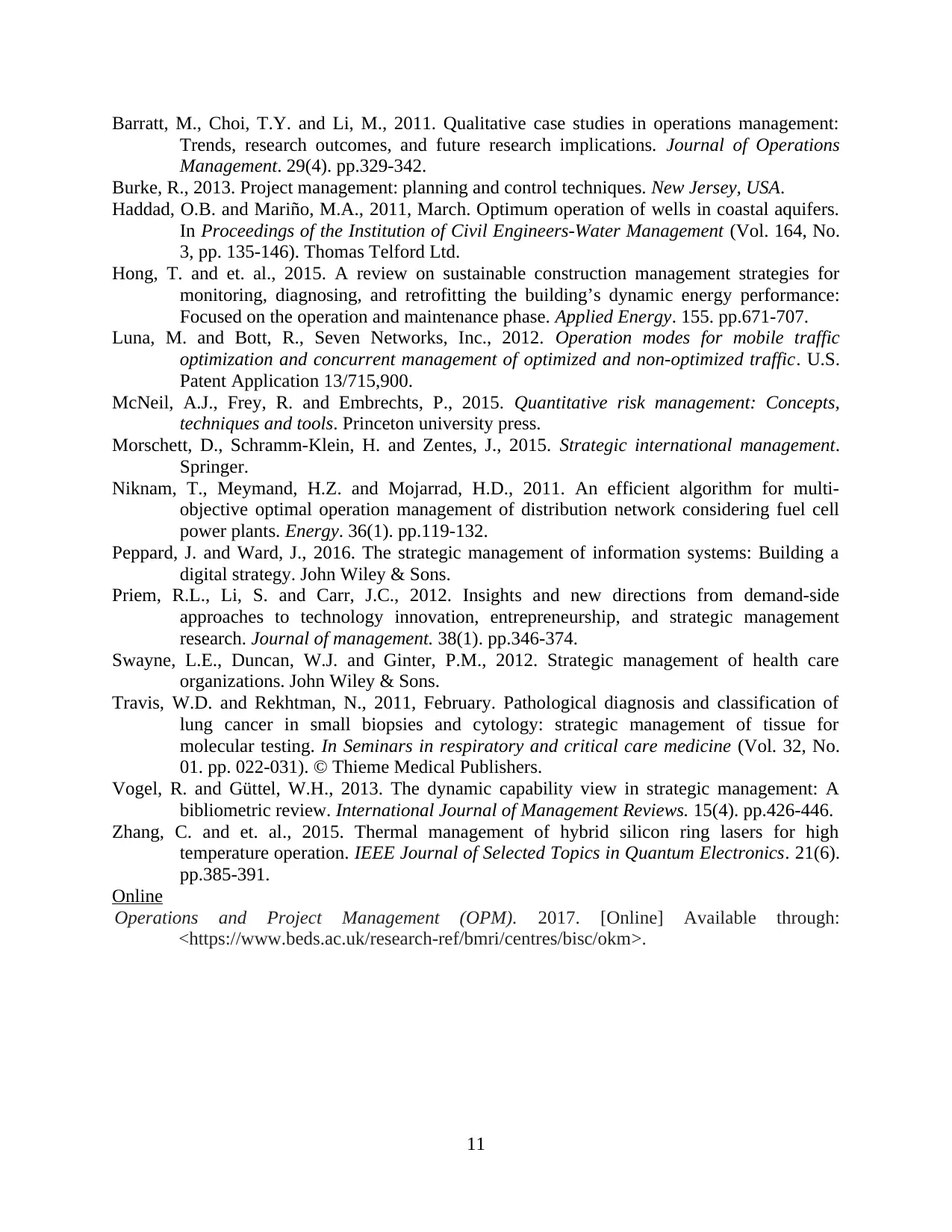
Barratt, M., Choi, T.Y. and Li, M., 2011. Qualitative case studies in operations management:
Trends, research outcomes, and future research implications. Journal of Operations
Management. 29(4). pp.329-342.
Burke, R., 2013. Project management: planning and control techniques. New Jersey, USA.
Haddad, O.B. and Mariño, M.A., 2011, March. Optimum operation of wells in coastal aquifers.
In Proceedings of the Institution of Civil Engineers-Water Management (Vol. 164, No.
3, pp. 135-146). Thomas Telford Ltd.
Hong, T. and et. al., 2015. A review on sustainable construction management strategies for
monitoring, diagnosing, and retrofitting the building’s dynamic energy performance:
Focused on the operation and maintenance phase. Applied Energy. 155. pp.671-707.
Luna, M. and Bott, R., Seven Networks, Inc., 2012. Operation modes for mobile traffic
optimization and concurrent management of optimized and non-optimized traffic. U.S.
Patent Application 13/715,900.
McNeil, A.J., Frey, R. and Embrechts, P., 2015. Quantitative risk management: Concepts,
techniques and tools. Princeton university press.
Morschett, D., Schramm-Klein, H. and Zentes, J., 2015. Strategic international management.
Springer.
Niknam, T., Meymand, H.Z. and Mojarrad, H.D., 2011. An efficient algorithm for multi-
objective optimal operation management of distribution network considering fuel cell
power plants. Energy. 36(1). pp.119-132.
Peppard, J. and Ward, J., 2016. The strategic management of information systems: Building a
digital strategy. John Wiley & Sons.
Priem, R.L., Li, S. and Carr, J.C., 2012. Insights and new directions from demand-side
approaches to technology innovation, entrepreneurship, and strategic management
research. Journal of management. 38(1). pp.346-374.
Swayne, L.E., Duncan, W.J. and Ginter, P.M., 2012. Strategic management of health care
organizations. John Wiley & Sons.
Travis, W.D. and Rekhtman, N., 2011, February. Pathological diagnosis and classification of
lung cancer in small biopsies and cytology: strategic management of tissue for
molecular testing. In Seminars in respiratory and critical care medicine (Vol. 32, No.
01. pp. 022-031). © Thieme Medical Publishers.
Vogel, R. and Güttel, W.H., 2013. The dynamic capability view in strategic management: A
bibliometric review. International Journal of Management Reviews. 15(4). pp.426-446.
Zhang, C. and et. al., 2015. Thermal management of hybrid silicon ring lasers for high
temperature operation. IEEE Journal of Selected Topics in Quantum Electronics. 21(6).
pp.385-391.
Online
Operations and Project Management (OPM). 2017. [Online] Available through:
<https://www.beds.ac.uk/research-ref/bmri/centres/bisc/okm>.
11
Trends, research outcomes, and future research implications. Journal of Operations
Management. 29(4). pp.329-342.
Burke, R., 2013. Project management: planning and control techniques. New Jersey, USA.
Haddad, O.B. and Mariño, M.A., 2011, March. Optimum operation of wells in coastal aquifers.
In Proceedings of the Institution of Civil Engineers-Water Management (Vol. 164, No.
3, pp. 135-146). Thomas Telford Ltd.
Hong, T. and et. al., 2015. A review on sustainable construction management strategies for
monitoring, diagnosing, and retrofitting the building’s dynamic energy performance:
Focused on the operation and maintenance phase. Applied Energy. 155. pp.671-707.
Luna, M. and Bott, R., Seven Networks, Inc., 2012. Operation modes for mobile traffic
optimization and concurrent management of optimized and non-optimized traffic. U.S.
Patent Application 13/715,900.
McNeil, A.J., Frey, R. and Embrechts, P., 2015. Quantitative risk management: Concepts,
techniques and tools. Princeton university press.
Morschett, D., Schramm-Klein, H. and Zentes, J., 2015. Strategic international management.
Springer.
Niknam, T., Meymand, H.Z. and Mojarrad, H.D., 2011. An efficient algorithm for multi-
objective optimal operation management of distribution network considering fuel cell
power plants. Energy. 36(1). pp.119-132.
Peppard, J. and Ward, J., 2016. The strategic management of information systems: Building a
digital strategy. John Wiley & Sons.
Priem, R.L., Li, S. and Carr, J.C., 2012. Insights and new directions from demand-side
approaches to technology innovation, entrepreneurship, and strategic management
research. Journal of management. 38(1). pp.346-374.
Swayne, L.E., Duncan, W.J. and Ginter, P.M., 2012. Strategic management of health care
organizations. John Wiley & Sons.
Travis, W.D. and Rekhtman, N., 2011, February. Pathological diagnosis and classification of
lung cancer in small biopsies and cytology: strategic management of tissue for
molecular testing. In Seminars in respiratory and critical care medicine (Vol. 32, No.
01. pp. 022-031). © Thieme Medical Publishers.
Vogel, R. and Güttel, W.H., 2013. The dynamic capability view in strategic management: A
bibliometric review. International Journal of Management Reviews. 15(4). pp.426-446.
Zhang, C. and et. al., 2015. Thermal management of hybrid silicon ring lasers for high
temperature operation. IEEE Journal of Selected Topics in Quantum Electronics. 21(6).
pp.385-391.
Online
Operations and Project Management (OPM). 2017. [Online] Available through:
<https://www.beds.ac.uk/research-ref/bmri/centres/bisc/okm>.
11
⊘ This is a preview!⊘
Do you want full access?
Subscribe today to unlock all pages.

Trusted by 1+ million students worldwide
1 out of 12
Related Documents
Your All-in-One AI-Powered Toolkit for Academic Success.
+13062052269
info@desklib.com
Available 24*7 on WhatsApp / Email
![[object Object]](/_next/static/media/star-bottom.7253800d.svg)
Unlock your academic potential
Copyright © 2020–2025 A2Z Services. All Rights Reserved. Developed and managed by ZUCOL.





